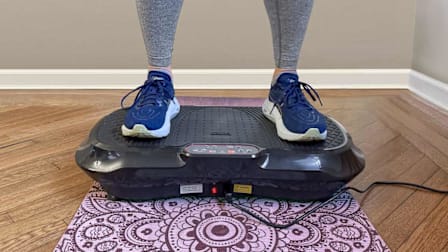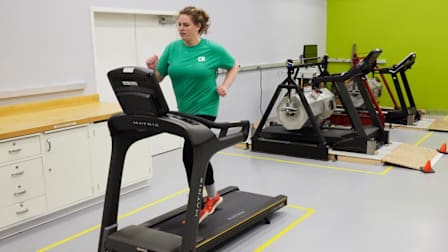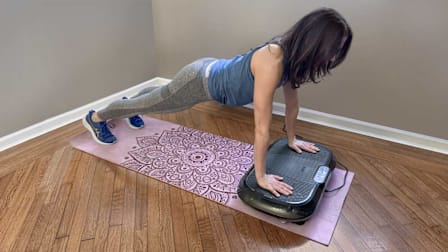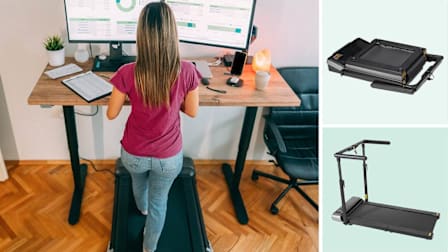How New Parents Can Actually Find the Time and Energy to Exercise
Yes, maintaining your fitness while parenting is possible—and working out is more than worth the effort
When you’re a new parent, finding time to exercise is probably not on the top of your to-do list. When confronted with hourly feedings, a screaming baby, and little sleep, donning your athleisure wear and going for a run might sound less appealing than ever. But exercising during your children’s crucial early years benefits your entire family, so finding a will and a way to fit it in pays off significantly.
“Both mothers and fathers lose hours of physical activity after they have a child those couple years while they go from infancy to toddlerhood,” says Dee Dlugonski, PhD, an assistant professor at the Sports Medicine Research Institute at the University of Kentucky in Lexington. “Learning to care for a new human being is time-consuming.”
How Much Do You Need to Work Out—and When Can You Start?
According to the American College of Obstetricians and Gynecologists (ACOG), people who have recently given birth should aim for about 150 minutes of moderate-intensity aerobic activity each week within a few days of giving birth. That might sound like a lot, but ACOG says you can break that up into three 10-minute walks each day. If you have a dog to walk or need to go to the grocery store or meet up with a friend, that’s reasonably doable, depending on how you feel physically.
If you were physically active before and during pregnancy, you can continue that same level of exercise after giving birth vaginally as long as you feel up to it. But if you had a complicated birth, a cesarean section, or lots of tearing, talk to your doctor first.
And if you aren’t the birthing parent, well, the only thing stopping you is—everything else. But that, too, is manageable.
Why Should You Exercise If You Have a Baby?
Most people know that exercising is good for the body. But there are particular benefits to being active when you’re a parent that are good for you and for your family.
Postpartum depression is a common mood disorder experienced by up to 1 in 7 new parents, including birthing parents, nonbirthing parents, adoptive parents, and surrogates. For some people, symptoms can be debilitating, but exercise can help. A 2019 systematic review of the available scientific literature found that exercising during pregnancy and after giving birth reduces the likelihood of postpartum depression and improves the quality of life (including such factors as physical pain, overall physical health, mental health, and social functioning). Notably, and perhaps counterintuitively to some, exercising during and post-pregnancy also mitigates fatigue.
All these benefits, though, don’t necessarily make it any easier to work out when you haven’t had more than a couple of hours of sleep in a row in months. Here’s how to create the ideal conditions and mindset to make that happen and reap the many rewards.
1. Find People Who Can Care for Your Baby
Before having a baby, you were probably able to put on your headphones and dive into a workout video or go for a jog, but with a baby, you’re much more restricted in terms of your physical movement. (After all, you can’t just put the baby in a crib while you take off to a spin class.) So finding support—from a partner, parent, babysitter, or roommate—is critical for making sure to take some time for yourself, Dlugonski says.
2. Surround Yourself With People Who Encourage You
Support is about more than logistics, it’s about motivation, too, Dlugonski says. “It could be someone who just encourages you to be active,” she says. “So it’s somebody who gives you positive reinforcement, somebody who says, ‘Hey, I know you want to be active, and you haven’t been able to do that in a few days. Do you want to go?’”
3. Coordinate, Coordinate, Coordinate
Ryan Rosso, who’s the dad of an almost-2-year-old boy, relies on his spouse’s support to get his regular workouts in. He and his wife do regular hourlong workout classes throughout the week and on weekends. His wife “goes before work and before the baby wakes,” he says. “I go in the evening after he goes to bed. On weekends, we hand him off in the parking lot.”
That kind of coordination can take a lot of work, and research shows that having a supportive partner willing and able to assist in the logistics of planning regular workouts as well as taking care of the baby while you’re exercising can significantly affect your likelihood of staying active.
4. Don’t Wait for Volunteers: Ask for Help
Sometimes spouses, friends, and family aren’t forthcoming with their support. In those cases, drumming up support can be as simple as asking, says Emily Mailey, PhD, an associate professor of kinesiology at Kansas State University in Manhattan. She also suggests writing up a “support contract,” in which you and your partner lay out exactly how you plan to help each other reach your goals. Specificity, in these instances, is preferable to vague goals such as “we will encourage each other to be more active,” Mailey says. Instead, pledge that “we will walk together for 30 minutes during our lunch hour on Monday, Wednesday, and Friday.”
Of course, if you’re a single parent or your partner is resistant to being supportive, finding social support might take a bit more work on your part. Meeting other new parents at a postpartum exercise class, for example, can open up avenues for friendships that may offer more support than what you get at home. Some exercise classes specifically for parents offer childcare support. (You can read more about integrating your baby into your exercise routine below.)
5. Be Flexible and Creative
I’m not saying you have to do an hour of Vinyasa yoga every day, though a regular yoga practice can help in more ways than one. Rather, one of the hallmark lessons of parenthood, as one of my co-workers put it, is remaining flexible amid constant changes and unexpected occurrences, because they’re pretty much guaranteed if you have kids. If you want to keep movement part of your life when you have a baby or a toddler, keeping an open mind and your schedule flexible is essential.
Flexibility and creativity are critical to a regular workout routine for a parent, Mailey says. She conducted a study in which half of the research participants, who were moms, were assigned to a Couch to 5k program, and the other half were assigned to generally try to fit in exercise wherever they could. She was surprised by the results. “I actually thought the Couch to 5K group might do better because it was a reasonable time commitment, a structured program; it’s designed to sort of build fitness gradually,” she says. But as it turns out, “just assigning someone to a running program wasn’t all that effective, and the group that got the recommendation to flexibly fit in what they could ended up being more active as the study went on.“
That’s not to say that Couch to 5k can’t be the thing that gets you to move every day, but rather that a structured workout program when you don’t have a schedule you can rely on may be hard to maintain. But if you love running, by all means, run!
“I always encourage people to find an activity they enjoy because at the end of the day, we’re going to stick with things we enjoy,” Dlugonski says. If that’s getting a partner or—if they’re unavailable or you don’t have one—a friend, family member, or trusted neighbor to watch your baby while you go for a jog, do it. If that’s placing the baby on a play mat while you do a yoga video, do that!
You might need to think a bit outside the box, too, because going to an hourlong spin class five days a week might be harder post-baby than it was pre-baby. “That’s another barrier for new parents: If they’re thinking about exercise in this traditional way with a gym membership, have to be on equipment or something, it just might not be feasible with small kids or a new baby,” Mailey says. Doing a workout at home or going for a walk might be more doable. “Everything counts, and it doesn’t have to be in this formal, structured setting necessarily.”
And that could mean housework, too: If you’re mopping your house, vacuuming the blinds, or doing yardwork, that counts as movement.
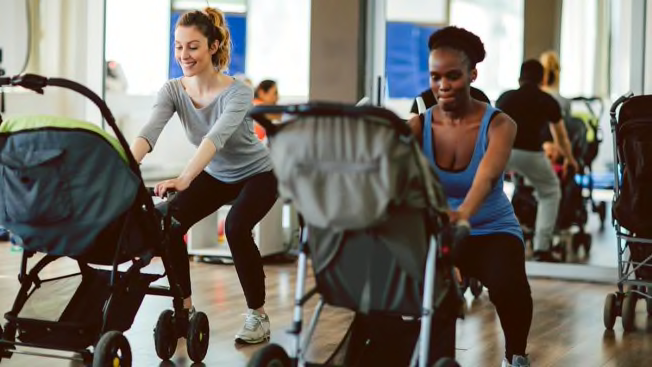
Photo: Getty Images Photo: Getty Images
6. Integrate Your Baby Into Your Workout
Anna Maltby regularly took her two kids to workout classes with other moms in order to stay active. After a few weeks of a deep core and pelvic floor recovery program, “I did Stroller Strides classes until maternity leave was over,” she says. “Stroller Strides is wonderful,” in part because one of her kids was a “screamer,” as she says, “and there was always someone to hold him or rock the stroller while I exercised.”
Parent-friendly fitness classes allow you to bring your baby along and stay safe while you work out, whether that means putting them on their own play mat while you do a yoga class or handing them off to a caretaker who will watch them for an hour. Classes such as Stroller Strides, Run Club+, Momleta Stroller Fitness, and Carifit are just a few options for exercise programs in which you can have your baby join in on the fun. (Just be sure to talk to your doctor and pediatrician to make sure it’s okay for you and your baby to participate.)
You don’t have to join a specific program, though; you can also go on long walks with other parent friends while pushing your baby in a stroller or walking him or her in a carrier, fulfilling both your social and your activity needs all at once.
7. Keep the Right Goals in Mind
Weight loss is a common concern among new parents. Many people think of working out as a ticket to weight loss, but as it turns out, weight loss isn’t a great long-term motivator when it comes to regular exercise. “Weight loss often doesn’t happen at the rate that people would hope or want, and that is discouraging if you feel like you’re putting in this work and not seeing the results you want,” Mailey says.
Health-related motivators in general don’t push parents to work out regularly, according to Dlugonski. Instead, immediate benefits like stress relief or more energy are more likely to encourage them to exercise consistently. “Rather than thinking about the fact that being active will reduce your cardiovascular risk in 20 or 30 years, you might think, ‘I’m active because [it helps me feel] energized,’ or ‘I’m active because it helps me to sleep better or makes me feel calm or happy,’” she says. “If weight loss is a goal, that’s fine. But you need to have other reasons, too, because there will be a point when your weight plateaus or you may gain weight for whatever reason,” and exercise has benefits far and beyond weight loss.
So what does that mean for you? Focus on the short-term, immediate positive effects of working out. Think about how a 20-minute jog helps you feel more energized and able to keep up with your toddler throughout the day, or how a morning yoga video gives you a sense of calm that’s necessary for caring for a fussy newborn.
When you’re a new parent, long-term goals like heart health are probably the least of your concerns, anyway. Putting those ideas on the back burner and thinking about what you gain from exercise today, rather than 20 years from now, will keep you active. And besides, who doesn’t need every bit of stress relief they can get when it’s 4 a.m. and your 1-year-old is still hungry?

















